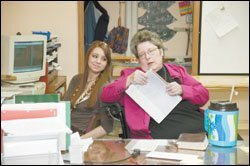“Imagine your limbs are melting.”
Norma Jean Taylor is going over a warm-up exercise with her high school drama students. “Limb by limb,” she explains, “you are going to melt into a puddle on the ground.”
Taylor cuts off their questions of how before the word has even left their lips.
“Use your imagination,” she says.
Thirteen girls and one boy do their best. They let their arms go limp. Then their legs. The students slowly collapse next to the books and flotsam stowed beneath their desks. Their lithe bodies sprawl at the feet of Taylor’s electric wheelchair.
“Use your imagination,” Taylor repeats in the same mantra-like tone.
Taylor doesn’t have to imagine. The teacher at Blue Ridge Christian School in Kansas City, Missouri, has spinocerebellar degenerative syndrome. In a word, she is melting. Under the influence of the disease, Taylor’s use of her limbs is slowly but irreversibly disappearing. She can still move her arms and legs, but they’ve long since gone numb, and she’s lost the strength to stand and the dexterity to write legibly.
The disease hasn’t yet taken her love of teaching, though it has forced her to radically alter her approach—to tell rather than show, as she’s doing this morning. But the 54-year-old isn’t the only one who’s had to change. The increasing debilitation has also forced her administrators, her colleagues, and her students into unfamiliar roles. Worse, it’s smuggled a load of unwelcome, unspoken questions into the tightly knit school—ones most teachers never have to face: What would you do if all you wanted to do was teach, and you literally could not do it? How much would your administrators support you? After a certain point, would students’ education begin to suffer? How much disability is too much?
So far, Taylor’s safety net is holding. The school has rallied behind her, and students have stepped up to take on more and more of the physical burdens of teaching, from writing on the whiteboard to connecting Taylor’s laptop computer. Headmaster Paul Wieduwilt has lightened Taylor’s teaching load and given her less-strenuous tasks. But they all know a difficult decision is coming. There will be a day when Taylor can no longer teach at all.
“The hard time is going to be when she physically cannot be in the classroom,” Wieduwilt says. “I hope she makes the decision. But I wouldn’t be surprised if it might come down to us.”
‘There’s never been a time in my life when I haven’t wanted to be a teacher,” Taylor says, her voice betraying a sadness that’s never heard in her classroom. She’s sitting in a windowless basement room of her home—the only part of the split-level she can get to from the garage with her wheelchair. “Teaching is me. I defined my life by teaching.”
Taylor grew up on a farm near Lockwood, Missouri, the daughter of a homebuilder and a bank secretary turned homemaker. As a child, she always considered school a “wonderful environment,” the unmarried teacher recalls, and she tries to imbue her own classroom at the preK-12 Christian school with that same nurturing feeling. But she also has a reputation for academic rigor that the disease has yet to dim. Her Blue Ridge colleague, Jamie Tripp, vividly remembers her fear at entering Taylor’s English class as a freshman a decade ago.
“Nothing she does is at a surface level,” Tripp says. “She forces you to dig deeper. As a student, I hated it.”
Yet Taylor became the teacher Tripp went to for support during the four months when her best friend wouldn’t talk to her. Tripp’s experience is hardly unusual. Again and again at graduations, during which honor students are warned against singling out teachers, “They almost always break that rule when it comes to ... Miss Taylor,” reports John Jakes, who teaches Bible classes at the school.
For more than a decade, Taylor was one of the teachers around which the roughly 400-student school was centered. Then she started having health problems. In the early 1990s, she suffered asthma attacks that would leave her gasping for breath. Doctors don’t believe those symptoms were connected to spinocerebellar degenerative syndrome, but they proved an ominous foreshadow.
By the end of the decade, she had steadily worsening balance problems and debilitating vertigo. Taylor was eventually forced to abandon her signature perambulations through the classroom, resting more and more against the desk as she taught. Then she perched on a stool behind a lectern and started carrying a cane. She was finally diagnosed in July 2004. “What I remember most is the look on [the doctor’s] face,” she recalls. “ ‘We’ve ruled out everything but spinocerebellar degenerative syndrome. It’s incurable. It’s progressive. You will never lose cognition, but gradually your motor skills will continue to deteriorate.’ ”

The neurological disease affects the cerebellum—the coordinating center at the base of the brain. Nerve signals that once told the legs and arms to move become less accurate or don’t function at all, explains Becky Kowalkowski, patient services director with the nonprofit National Ataxia Foundation. Kowalkowski says sufferers of the disease, which afflicts an estimated 150,000 Americans, first notice themselves tripping more often. They have troubles with their hands or develop tremors. They begin to slur their speech or have trouble swallowing. Eventually they are confined to wheelchairs. And it often leads to fatal complications, such as pneumonia.
Soon after Taylor’s diagnosis, a social worker stopped by to explain how to file for disability, but Taylor wouldn’t hear of it. She returned to school that fall, albeit in a wheelchair. “I came in, and I was going to do everything I had before,” she remembers. “I was going to show everyone.” She ultimately made it through the year, though she missed 45 days of school and had to cut her class load from seven to five. She also made the decision she calls her “greatest sorrow”: to pass on directing the school play for the first time in 19 years.
Several framed displays hang from her classroom wall—mementos of shows from years past. One poster includes a 1985 photograph from the closing-night performance of Fiddler on the Roof—her directorial debut at Blue Ridge. In the picture, Taylor clutches a congratulatory bouquet, sturdy legs extending from her peach skirt, her pumps dyed to match.
Twenty years later, Taylor can’t even make it to class on some days, though Tripp and other teachers obligingly cover her classes when her health fails. Jakes has done even more. He provides emergency rides to school. He’s across-the-hall tech support for her computer. And he prepares her asthma medicine each morning. He also headed up the crew of volunteers that retooled the basement room of Taylor’s house to make it wheelchair accessible.
Taylor scoffs at well-meant assurances from students and others that her illness hasn't affected her teaching: 'It's hurt the class very, very much.'
“Without getting too spiritual, it is the task of Christian individuals to help others in need,” he says.
Not everyone is so accommodating. Some students try to take advantage of Taylor’s disease, Jakes acknowledges—usually the same ones who in the past would have complained to their parents about her challenging style. But now they have a target for their frustration. “The students that do not like how she’s pushing them, ... when she gives an instruction they don’t understand, they blame the disability,” Jakes says.
But an informal clutch of students also looks after her. They call themselves Miss T’s Honor Guard. When asthma was Taylor’s biggest worry, they enforced a no-perfume-in-the-halls policy. As her health continued to deteriorate, they stepped up to fetch books, connect her computer for PowerPoint presentations, and help out in other ways. “I’m learning to ask for help, which is good,” Taylor says.
Although she can no longer do all she’d like in the classroom, her students say it feels like business as usual, with kids pestering her for rides on the back of her wheelchair and teasing her when she clips the door frame leaving the room. “I don’t think it’s affected her teaching at all,” asserts junior Sarah Snow. “She’s still just as strong of a teacher as my freshman year.”
While Taylor sees it differently—“It’s hurt the class very, very much,” she insists—she acknowledges her own need to be in the classroom. “If she didn’t teach, she wouldn’t be out of the bed,” Jakes affirms. “It is paramount.”
But as important as teaching might be for an individual, school administrators have to look out for their institutions as a whole. Though her instructional load has been cut nearly in half, headmaster Wieduwilt, who’s been at Blue Ridge for more than 30 years, has assigned her to work part time on the school’s accreditation with the Association of Christian Schools International, from home as needed, so she can remain a full-time employee.
“Private schools probably have a little more leeway or flexibility in accommodating her,” observes Susan Gabel, an associate professor of education at National-Louis University in Chicago and an expert on disability studies. “What [Blue Ridge] did with her could be more difficult to do because of union rules” at public schools.
Even with administrative support, Taylor has had troubles. She’s been hospitalized eight times since she was diagnosed. She’s suffered vertigo and exhaustion, and in October, she passed out during her morning planning period. A student found her on the floor next to her wheelchair.
But Gabel says it’s possible that her experiences may also bring some unexpected benefits to her students. “Think of the life lessons the kids are learning and the model she’s setting for them, some of whom will become disabled over their lives,” she notes.

Sharon Snow, Sarah’s mother, agrees. “She still remains part of the solid rock that holds that school together.”
During her college prep English class just before lunch, Taylor rolls over to a closet shelf to retrieve a sewing basket. From it, she passes around a brilliant-white pillow adorned with an intricately stitched star pattern. She tells the class she made the pillow a few years ago.
“Because I teach teens, I need something to relax me,” she half-jokes. “Quilting was my joy, and I loved it. This took me an hour.”
She takes another project from the basket, an embroidery hoop. Though it is the same star pattern in colored thread, this project has the look of a child’s God’s eye made with Popsicle sticks and yarn. “I’ve been working on this one since July of 2004,” Taylor announces. “It’s an assignment for occupational therapy to keep what’s left of my hands working.
“Which work am I more proud of?” she asks the class. “Defend your answer.”
After comparing the projects to video games and a child’s first writing, the students reach a consensus that the more recent project must make Taylor more proud because it has been such a challenge.
Taylor listens but doesn’t answer her own question. Not until later, with the cold of the fall evening creeping into her basement room at home, does she confide that she’s more proud of the first, perfect pillow.
“The eternal optimism of youth,” she says of her students’ speculation. Her energy of the morning is now gone, and her voice is melancholy. “I used to take joy in quilting. Now it’s an assignment.”



